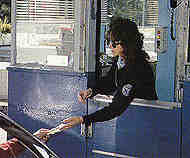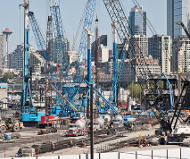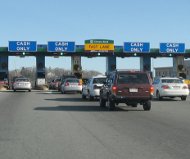Texas and other Gulf states may not be ready when their ship comes in.
A massive expansion of the Panama Canal is on track to be completed in about two years, making it possible for huge ships often carrying goods from Asia to bypass their usual stops in the Los Angeles/Long Beach area and instead sail directly to Texas and other states along the Gulf of Mexico, as well as the East Coast. From there, the freight could be put on trains and trucks and shipped across the country -- potentially generating billions of dollars and creating thousands of jobs not only on the coasts but also in major inland hubs such as Dallas-Fort Worth.
But Texas and other Gulf states are woefully unprepared to handle the goods brought to the area on enormous ships soon to pass through the canal, several experts said. The region's ports aren't deep enough to handle the ships, although the Port of Houston plans to deepen its berths in front of its container terminals to 45 feet by 2014. Still, farther inland, highways and rail lines lack the capacity for additional freight traffic.
Officials in those states are scrambling to calculate what kinds of transportation improvements need to be made and how to pay for them. It's unlikely that major infrastructural improvements will be completed by the scheduled August 2014 opening date of the new canal locks, so advocates say the real question is how many years will go by before the states on the southern end of America's breadbasket make a genuine effort to steer more of the shipping business their way.
"Really, we're not ready. We've been kind of sitting on our toes for the last two years because of the economy," said Tim Welch, a North Richland Hills city councilman and chairman of Transportation Excellence for the 21st Century, a Dallas-area group that advocates for regionwide mobility funding.
Welch visited the canal in 2010 as part of his TEX-21 duties and plans to go again this year. He sees the widening as a potential boon to North Texas, where companies such as Fort Worth-based BNSF Railway are in a good position to handle additional freight from facilities such as the Intermodal Yard in Haslet.
"We can actually feed the north and central parts of the United States, but we need to get on the ball and focus on our transportation needs," Welch said. "With these big supercontainers, no one has really looked down the future and said, 'Are we ready for this?' We have a great opportunity: With where Texas is located and with inland ports, we can actually get a lot of freight out of Houston and up the major highways of Interstate 35 and 45.
"It's going to be a lot of competition in these states to increase the capacity."
But not everyone agrees that the canal expansion will cause a spike in Gulf Coast shipments.
"It's been our position for quite some time that the impact of the new Panama Canal lock will be relatively minimal," said John Lanigan, BNSF executive vice president and chief marketing officer. BNSF specializes in hauling shipments from West Coast seaports to inland destinations.
A shipment going through the canal and arriving at Houston could take 10 days to two weeks longer to reach its destination than a shipment arriving at a West Coast seaport with a rail connection, he said.
"It's generally based on where it's going to be consumed and how long it's going to take to get there," Lanigan said.
But he agreed that Texas and other states should plan for growth at all seaports and ground transportation connections.
"We think ports over time are going to grow because the population is going to grow," he said. "Anything that makes the supply chain more efficient, which this will, is good for the economy."
Canal makeover
The canal expansion is the biggest project there since original construction was completed in 1914. The canal, which the U.S. handed over to Panama in 1999, can handle ships up to 106 feet wide, 965 feet long and 39 feet deep but after expansion will be able to handle ships up to 161 feet wide, 1,200 feet long and 49 feet deep. Some of those larger ships can carry nearly triple the cargo of the ships going through the canal today.
But will any of those boats stop in the Gulf, or will they simply go to the East Coast or elsewhere in the Atlantic Ocean? The U.S. lacks deep-water ports on its southern shores, with limited options between Los Angeles and Norfolk, Va., officials said.
In many instances, those ports can use federal funds or raise their own dollars through debt to make the necessary improvements.
As for highways and rail lines, there are scant resources for new projects. But existing dollars, including funding from state and federal motor fuels taxes, could be steered toward projects that benefit freight movement.
Texas response
The Texas Transportation Department, for example, is creating a canal stakeholder working group to give input in the state's planning for roads, rail and other parts of the grid. The working group includes BNSF, the Texas Farm Bureau, Texas Motor Transportation Association and Texas Association of Manufacturers.
The idea is to develop multiple Texas ports for deep-water vessels and build roads and rail lines to support them, said Bill Meadows of Fort Worth, a Texas Transportation Commission member who has also been to the canal.
"Texas doesn't need to be picking between Corpus Christi and Houston. Let them all have their competitive gigs going on," Meadows said. "TxDOT is going to put together a state marketing plan that highlights the connectivity features of the state's transportation system. Our $1.4 billion expansion of Interstate 35 figures prominently into this discussion -- and I-35W and I-35E expansion [in Fort Worth and Dallas] figure prominently into the discussion."
The working group will be asked to put together a document over the next six months or so highlighting how goods from the canal could be shipped into the interior of the U.S. after arriving at a Texas port.
Last week in Houston, a state House interim transportation committee held a meeting to take comments about the potential impact of canal freight. Additional funds of $1 billion to $3.5 billion may be needed to prepare roads, rail lines and other transportation components for the additional freight, one official testified.
But the state shouldn't be left paying that bill by itself, said committee chairman and state Rep. Larry Phillips, R-Sherman.
"There's a federal fee charged on containers that goes to the federal government, and they get $125 million to $135 million in Houston. We get about $25 million back," Phillips told the Star-Telegram in a phone interview.
He said he toured the Port of Houston last week and learned of its plans to pay for improvements including the dredging, as well as installing larger cranes to accommodate the bigger ships. The improvements could cost up to $150 million and are being paid for locally because Port of Houston officials say applying for federal funding could delay the project by a decade.
But Phillips said that many other improvements will be needed and that the region should ask for federal dollars for those projects.
"We have to address at-grade crossings through the Harris County area to get to San Antonio or Dallas or Fort Worth or other places around the state," he said. "We have to look at investing in rail relocation. The other thing is what the highways can take. We hope the federal government will help return our tax dollars and help make those investments in our ports and infrastructure."
Public pitch
Officials who support increased funding for freight movement across Texas may face resistance from the public, which rejected Gov. Rick Perry's vision for the Trans-Texas Corridor, a planned statewide grid of toll roads, rail lines and utilities that was abandoned several years ago because of opposition from thousands of residents.
Many components of the Trans-Texas Corridor plan live on, however, in the state's transportation planning. For example, one group recently submitted a proposal to build a freight rail line parallel to the Interstate 35 corridor, and the proposal is being evaluated by the Transportation Department.
But Phillips believes that Texans are regaining confidence in the Transportation Department, which in recent years has undergone two sunset reviews and had a leadership change.
For example, Welch said, the Port of Freeport estimates its return on investment in widening its channel will be $2 for every $1 spent.
Phillips believes the public will support investment in projects that improve freight movement if they're convinced that the return is worthwhile.
"We had to go through a restructuring of TxDOT," he said, "so the citizens know their dollars were going to be invested wisely."
 The Congressional Budget Office (CBO) on Thursday released a report on the strengths and weaknesses of the proposal to create a national infrastructure bank. The bank idea has grown increasingly popular among transportation officials and politicians because it allows them to raise more money from motorists to fund transportation projects.
The Congressional Budget Office (CBO) on Thursday released a report on the strengths and weaknesses of the proposal to create a national infrastructure bank. The bank idea has grown increasingly popular among transportation officials and politicians because it allows them to raise more money from motorists to fund transportation projects.
 Like TURF
Like TURF Follow TURF
Follow TURF

 Imposing tolls on freeways and tunnels may not actually reduce congestion. An analysis of the Alaskan Way Viaduct replacement project by the Washington State Department of Transportation (WSDOT) suggest tolling merely takes the traffic that would otherwise have been on the high-capacity highway and transfers it to another, untolled route -- usually a lower-capacity side street.
Imposing tolls on freeways and tunnels may not actually reduce congestion. An analysis of the Alaskan Way Viaduct replacement project by the Washington State Department of Transportation (WSDOT) suggest tolling merely takes the traffic that would otherwise have been on the high-capacity highway and transfers it to another, untolled route -- usually a lower-capacity side street. In testimony this week on Capitol Hill the states' highway lobby AASHTO (Association of American State Highway and Transportation Officials) argued against Senator Frank Lautenburg's so-called Commuter Protection Act, S2006. Speaking for AASHTO North Carolina DOT head Eugene A Conti said enactment of the bill would add great uncertainty to financing of toll projects and discourage states and local authorities from advancing projects that would have to gain federal clearance for toll rates.
In testimony this week on Capitol Hill the states' highway lobby AASHTO (Association of American State Highway and Transportation Officials) argued against Senator Frank Lautenburg's so-called Commuter Protection Act, S2006. Speaking for AASHTO North Carolina DOT head Eugene A Conti said enactment of the bill would add great uncertainty to financing of toll projects and discourage states and local authorities from advancing projects that would have to gain federal clearance for toll rates.
 and Florida, the share is even higher."
and Florida, the share is even higher." Money raised from tolls on one road can be diverted to fund projects on unrelated, untolled bridges, roads and tunnels, the Massachusetts Supreme Judicial Court ruled Thursday. In 1997, the state legislature tapped drivers on the Massachusetts Turnpike for revenue to pay for the "Big Dig," a massive tunnel project in Boston with legendary cost overruns that brought the initial $2.8 billion estimate to a final pricetag of $22 billion.
Money raised from tolls on one road can be diverted to fund projects on unrelated, untolled bridges, roads and tunnels, the Massachusetts Supreme Judicial Court ruled Thursday. In 1997, the state legislature tapped drivers on the Massachusetts Turnpike for revenue to pay for the "Big Dig," a massive tunnel project in Boston with legendary cost overruns that brought the initial $2.8 billion estimate to a final pricetag of $22 billion.